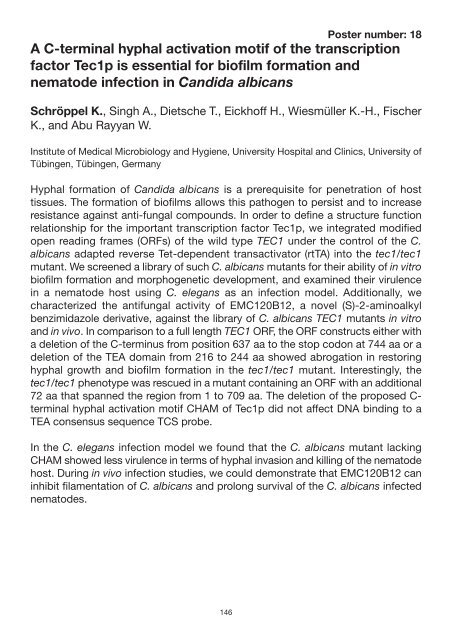Candida Infection Biology – fungal armoury, battlefields ... - FINSysB
Candida Infection Biology – fungal armoury, battlefields ... - FINSysB
Candida Infection Biology – fungal armoury, battlefields ... - FINSysB
Create successful ePaper yourself
Turn your PDF publications into a flip-book with our unique Google optimized e-Paper software.
Poster number: 18<br />
A C-terminal hyphal activation motif of the transcription<br />
factor Tec1p is essential for biofilm formation and<br />
nematode infection in <strong>Candida</strong> albicans<br />
Schröppel K., Singh A., Dietsche T., Eickhoff H., Wiesmüller K.-H., Fischer<br />
K., and Abu Rayyan W.<br />
Institute of Medical Microbiology and Hygiene, University Hospital and Clinics, University of<br />
Tübingen, Tübingen, Germany<br />
Hyphal formation of <strong>Candida</strong> albicans is a prerequisite for penetration of host<br />
tissues. The formation of biofilms allows this pathogen to persist and to increase<br />
resistance against anti-<strong>fungal</strong> compounds. In order to define a structure function<br />
relationship for the important transcription factor Tec1p, we integrated modified<br />
open reading frames (ORFs) of the wild type TEC1 under the control of the C.<br />
albicans adapted reverse Tet-dependent transactivator (rtTA) into the tec1/tec1<br />
mutant. We screened a library of such C. albicans mutants for their ability of in vitro<br />
biofilm formation and morphogenetic development, and examined their virulence<br />
in a nematode host using C. elegans as an infection model. Additionally, we<br />
characterized the anti<strong>fungal</strong> activity of EMC120B12, a novel (S)-2-aminoalkyl<br />
benzimidazole derivative, against the library of C. albicans TEC1 mutants in vitro<br />
and in vivo. In comparison to a full length TEC1 ORF, the ORF constructs either with<br />
a deletion of the C-terminus from position 637 aa to the stop codon at 744 aa or a<br />
deletion of the TEA domain from 216 to 244 aa showed abrogation in restoring<br />
hyphal growth and biofilm formation in the tec1/tec1 mutant. Interestingly, the<br />
tec1/tec1 phenotype was rescued in a mutant containing an ORF with an additional<br />
72 aa that spanned the region from 1 to 709 aa. The deletion of the proposed Cterminal<br />
hyphal activation motif CHAM of Tec1p did not affect DNA binding to a<br />
TEA consensus sequence TCS probe.<br />
In the C. elegans infection model we found that the C. albicans mutant lacking<br />
CHAM showed less virulence in terms of hyphal invasion and killing of the nematode<br />
host. During in vivo infection studies, we could demonstrate that EMC120B12 can<br />
inhibit filamentation of C. albicans and prolong survival of the C. albicans infected<br />
nematodes.<br />
146


